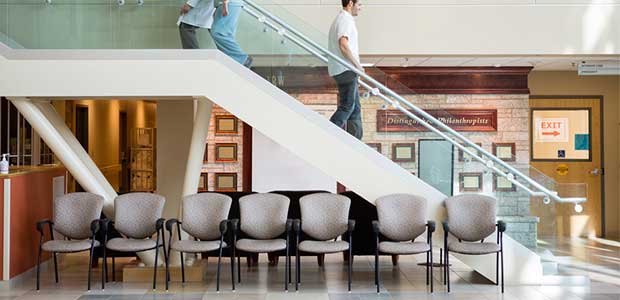
Six Environmental Controls to Reduce Healthcare Worker Stress During COVID
Frontline healthcare workers face enormous amounts of stress, and burnout is common. Here are six ways you can facilitate emotional wellbeing for your healthcare workers—just by rethinking the environment they work in.
Healthcare workers are normally prone to burnout and stress with long hours, difficult work situations and patients and high job expectations. During the coronavirus pandemic, those stressors are worsened with concern about the virus, concern about their own health or their families’, grief over watching patients die and anxiety over resources and PPE.
In fact, these issues are increasing healthcare provider stress and harming their mental health, said one Forbes article, as some begin to show symptoms similar to post-traumatic stress disorder.
In 2019, a survey reported that fifteen percent of nurses reported feelings of burnout—which can decrease work performance and increase risk of errors.
While there are a number of management and team-building ways you can help employees to decrease burnout, there are a number of environmental changes that you can implement to boost employee resilience. Mindfulness micro practices—like small breaks and a variety of respite spaces in which to take them—can mitigate stress.
Here are six environmental controls to implement for your healthcare workers, from Forbes:
Rethink the Break Room
Taking breaks is very important for healthcare worker health, but many may be reluctant to take them. When caregivers do take breaks, though, the environment needs to be optimal for decompression, support and restoration.
Make the break room comfortable, welcoming and calming. Put plants or flowers in the room, facilitate natural light or even hang art or wall graphics. You can include books and magazines in the room or provide a radio.
Leverage Underutilized Corridor Spaces
Forbes points out the benefit of having corridor spaces also have places of comfort. You can place chairs and couches along the corridor of a physician’s daily rounds. It is nice to have corridors that end with a window, or a door to an outdoor space for staff to take a visual break.
Provide Areas for Physical Exercise
Physical activity or any form of movement is proven to help individuals destress, refocus and mentally recharge. Exercise has short- and long-term benefits like cognitive functioning and improved memory. Give workers access to a gym membership, or even access to a nearby walking trail.
Offer Immersive Respite Pods
A space that encourages workers to relax and recharge has immense importance. Make an immersive respite pod, room or area with inviting seating, adjustable lighting, calming sounds and nature imagery. If you have the means to spend on individual pods, you can place these all over the worksite like in waiting rooms or lobbies.
Decrease Bedside Stress
It is pretty amazing how much sounds affect our alertness and reaction times. In a hospital or healthcare facility, there are sounds everywhere: alarms, rolling carts, beeping machines—you name it. The Forbes article explains how “alarm fatigue” or a person’s getting used to alarms can provoke a negative immune system response, lower concentration, decrease focus and memory and raise cortisol levels.
Mitigating these sounds in the workplace is very doable. You can provide white noise in some areas, employ sound-absorbing materials or use smoother cart wheels.
Consider the Return on Investment
All things cost money, as do environmental changes like these. Healthcare facilities are often already tight on money and might not have large budgets for large environmental changes. However, you should consider the overall, long-term benefits of your employees by making these changes, and that might be enough to spend the money.
Last year, before the pandemic, healthcare organizations on average faced 17.8 percent staff turnover. This came at a huge cost, averaging more than $60,000 for replacing a registered nurse and $500,000 for replacing a physician. By decreasing staff turnover but just 2 percent, you could save an average hospital over half a million dollars per year—and this could quickly offset the construction cost for many environmental solutions.
Healthcare workers have always worked to put the patient first, and during the current pandemic, our communities need them more than ever. With high turnover rates and likelihood of burnout, it is crucial to consider the mental and emotional wellbeing of the people on the frontlines of human health.